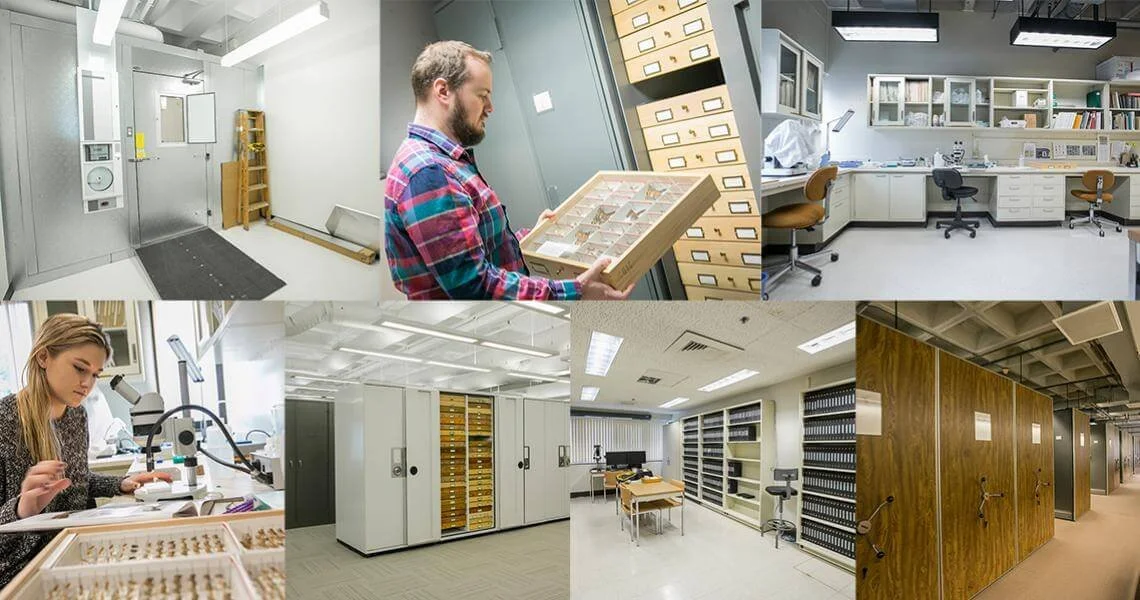Cornell University Insect Collection (CUIC)
With over 7 million specimens, the CUIC is one of the world’s top entomological collections with over 200,000 species of insects, or roughly 20% of all the world’s described insect fauna.
Almost all the specimens on display in this exhibit are from the scientific holdings of the CUIC. CUIC’s diverse mission supports basic and agricultural research, detects invasive and introduced species, provides undergraduate and graduate education, and shares passion and knowledge through outreach and public education. Nearly every entomologist in the United States today can trace their history of training back to Cornell University.
This world-class collection is an important scientific resource and serves as a permanent home for scientifically valuable specimens and their associated data. The CUIC represents global insect diversity, with specimens from almost every country on the planet. It also includes species of economic importance and vouchers from scientific studies. Each specimen label in the collection records where, when, and by whom it was collected, and often includes other biological and ecological information.
Cornell entomologists have gone collecting across the globe and this map shows the countries (in black) that CUIC's holdings cover.
Madagascan Sunset Moth
Urania ripheus
Did You Know 🔍
The Cornell University Insect Collection is among the top 20 largest insect collections in the world.
The CUIC and its staff engage in insect research, identification, education, training, mentoring, and public outreach for the global community.
A World-Class Specimen Collection
The Cornell University Insect Collection began 150 years ago in the famed McGraw Tower, when chimesmaster John Henry Comstock began teaching entomology at Cornell University in 1871.
Early curators of the CUIC mounted expeditions around the world to collect diverse specimens for teaching and research, including one of the first motorized cross-country trips in the United States. For nearly two years between 1917–1919, the expedition drove three cars across the U.S., camping and collecting all along the way. Undescribed species are still being discovered from the collections of this expedition. The CUIC continues to grow in size and importance today.
The most scientifically valuable specimens in our collections are called “type specimens.”
When taxonomists (scientists who study and describe biodiversity) describe a new species, they must choose one specimen to serve as the original physical example of the species. This is called the “holotype.” Taxonomists compare newly collected specimens with such type specimens to help with identifications or to determine if they have found a new, unnamed species.
The CUIC currently has ~2700 holotype specimens and an additional ~5000 other types. Without type specimens, it would be impossible to identify the majority of insect species, and we would never see the true diversity of the insect world.
Insect Diagnostic Lab
Expert Identification
The Insect Diagnostic Lab (IDL), part of the CUIC, provides expert identification of potential insect pests and management recommendations.
The general public submits about 900 samples per year, varying from common household insects to new invasive species. We deal with everything from casual gardeners to international lawsuits and scientific researchers to UFOlogists. The IDL also provides identification services for both state and federal government agencies to assist with their efforts to detect and monitor various invasive species.
The two largest pest projects we currently oversee are for European cherry fruit fly (Rhagoletis cerasi), a potential pest of commercial cherries, and boxtree moth (Cydalima perspectalis), a pest of ornamental boxwood. Both of these species are currently spreading in the Niagara Region of New York.
Box Tree Moths
Cydalima perspectalis
European Cherry Fruit Fly
Rhagoletis cerasi
Did You Know 🔍
Why is it important to have more than one specimen of the same species?
Insect specimens do more than simply document which species live in a particular location. The more samples we collect, the better we can understand a species’ geographic range and anatomical variations. By looking at many individuals of the same species, we can study changes in range, distribution, and biology over time.
The CUIC contains over 19,000 drawers. Stacked on top of each other, this would make a tower which is 3 times as tall as the Empire State Building or 22 times as tall as Taughannock Falls. Alternatively, laid out in a line side-by-side, it would stretch almost the distance from Museum of the Earth to Taughannock Falls!











